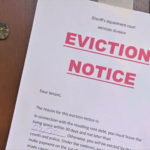A reference of Kansas Eviction Laws, and steps of the Kansas eviction process for landlords and renters, updated 2021.
- What are the reasons that landlords can evict tenants under Kansas eviction laws?
- Nonpayment of rent (KS Stat §58-2564).
- Material non-compliance with the lease agreement (KS Stat §58-2564).
- Non-compliance with the lease agreement that affects health or safety ((KS Stat §58-2555).
- Tenant remains in possession of the dwelling unit after the occupancy period without the landlord’s permission (KS Stat §58-2570).
- What notice do Kansas eviction laws require that landlords provide tenants before starting the eviction process?
- For evictions in Kansas based on non-payment of rent, the landlord must give a 3-day notice to the tenant. (KS Stat §58-2564(b)).If the tenant pays the rent during that period, the tenant cannot be evicted. If the tenant does not pay rent, the landlord can seek judicial relief.
- For evictions based on non-compliance of the lease agreement, the landlord must give a 30-day notice of non-compliance. The notice must state the acts and omissions that constitute the breach and that the rental agreement will terminate on a date at least 30 days past the date the tenant receives the notice. The tenant has 14 days to remedy the issue, if possible. If the tenant remedies the issue within 14 days, the agreement does not terminate. However, if the tenant breaches the lease again, the landlord can give them a new 30-day notice and they will not have an opportunity to remedy the breach. (KS Stat §58-2564(a)).
- For evictions based on a health or safety violation, the landlord must provide a 30-day notice to the tenant and give them a chance to remedy the problem. (KS Stat §58-2564(a)). The notice must state the acts and omissions that constitute the breach and that the rental agreement will terminate on a date at least 30 days past the date the tenant receives the notice. The tenant has 14 days to remedy the issue, if possible. If the tenant remedies the issue within 14 days, the agreement does not terminate. However, if the tenant breaches the lease again, the landlord can give them a new 30-day notice and they will not have an opportunity to remedy the breach.
- For evictions based on a holdover tenancy, the landlord must provide a 30-day notice before terminating the lease. (KS Stat §58-2570).
- Do Kansas eviction laws allow landlords to use “self-help eviction” methods, such as locking a tenant out of the rental unit or shutting off the utilities?
- No. Kansas law prohibits landlords from removing or excluding the tenant from the rental unit or interrupting utility services to the unit. If the landlord does these things, the tenant can recover their actual damages or 1.5 times their monthly rent, whichever is greater. (KS Stat §58-2563).
Kansas Eviction Process: Step-by-Step
To initiate the Kansas Eviction Process:
- Serve the Eviction Notice. The landlord must serve the tenant with the proper notice that states why the tenant is being evicted and gives the proper number of days of notice. The landlord can serve the notice by:
- Personally serving the tenant
- Serving another person who lives in the unit who is over 12 years of age
- Posting a copy of the notice in a noticeable place on the rental property
- Mailing the notice (KS Stat §58-2564(b)).
- File Eviction Lawsuit. The landlord begins the official eviction process in Kansas by filing a summons and eviction petition or petition for eviction and rent (in the case of non-payment) with the superior court where the property is located.
- Schedule Court Hearing. The court sets a hearing date 3 to 14 days from when the summons and petition are filed. The landlord is responsible for serving these documents to the tenant.
- Answer the Lawsuit or Default. Once the tenant receives the summons and petition, they can file a written answer to contest the eviction. This answer must be filed within the time designated on the summons.
- Attend the Hearing. The tenant and landlord attend the hearing and present their side of the case. If the tenant does not appear, the landlord can request a default judgment in their favor. The landlord can also request a writ of restitution and execution to finalize the eviction.
- Appeal the Decision. If either party disagrees with the court’s decision, they have five days to appeal the decision. The tenant cannot be removed during this five-day period. If the tenant files an appeal, they can request a stay of execution so that they are not removed from the premises while the case is still pending.
- Request a Writ of Restitution. If the landlord wins the case and the tenant does not appeal, they can request a writ of restitution and execution and return that provides the legal authority for a marshal to physically remove the tenant from the premises.







